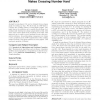Free Online Productivity Tools
i2Speak
i2Symbol
i2OCR
iTex2Img
iWeb2Print
iWeb2Shot
i2Type
iPdf2Split
iPdf2Merge
i2Bopomofo
i2Arabic
i2Style
i2Image
i2PDF
iLatex2Rtf
Sci2ools
COMPGEOM
2010
ACM
2010
ACM
Adding one edge to planar graphs makes crossing number hard
A graph is near-planar if it can be obtained from a planar graph by adding an edge. We show that it is NP-hard to compute the crossing number of near-planar graphs. The main idea in the reduction is to consider the problem of simultaneously drawing two planar graphs inside a disk, with some of its vertices fixed at the boundary of the disk. This approach can be used to prove hardness of some other geometric problems. As an interesting consequence we obtain a new, geometric proof of NP-completeness of the crossing number problem, even when restricted to cubic graphs. This resolves a question of Hlinˇen´y. Categories and Subject Descriptors F.2.2 [Analysis of Algorithms and Problem Complexity]: Nonnumerical algorithms and problems—Geometric problems and computations; Computations on discrete structures; G.2.2 [Discrete Mathematics]: Graph theory— Graph algorithms General Terms Algorithms, Theory Keywords Topological graph theory, planar graphs, crossing number, NP-hard, graph dra...
| Added | 10 Jul 2010 |
| Updated | 10 Jul 2010 |
| Type | Conference |
| Year | 2010 |
| Where | COMPGEOM |
| Authors | Sergio Cabello, Bojan Mohar |
Comments (0)

